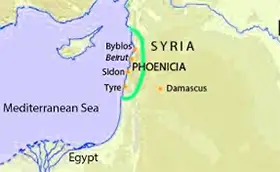Ancient Byblos
Byblos was the first of the ancient Phoenician cities to be settled, sometime before 7000 B.C. At its founding, it was called Gebal (or Gubla). 
The city's port made it advantageous to build ships in order to trade with other civilizations; indeed, Byblos was one of the first known cities to do so. Their craft at shipbuilding was well-known in the histories of neighboring civilizations, such as Ancient Egypt and Ancient Israel. One of the main exports of Byblos was the famed Cedars of Lebanon, and Egypt was one of the city's largest buyers. The warlike Amorites arrived in force in 2150 B.C. and conquered Byblos, burning the city badly in the process. One invader displaced another when the Hyksos invaded, in 1725 B.C. The Hyksos had taken over Lower Egypt as well; and when the Egyptians under Ahmose I rose up and drove out the Hyksos, they carried on to the north and drove them out of Byblos as well; Egypt then settled in for an occupation of its own. The Amarna Letters include communication between the Byblos king Rib-Hadda and the Egyptian pharaoh Akhenaten. 
Despite this series of takeovers, the people of Byblos carried on with their production and their trade, as well as they could; and it was during this time that they contributed to world advancement with what is perhaps their most important innovation: the alphabet. Their 22-letter scheme replaced cuneiform as the language of choice in written communication and spread throughout the Mediterranean. The 22 letters were all consonants. The Phoenicians did use vowels but didn't include them in their list of alphabetic characters. The Greeks and later the Romans adopted or adapted this alphabet. Byblos, like the rest of Phoenicia, came under the sway of various kings of the Assyrian Empire, in the 7th Century B.C., and of the Persian Empire in the 5th Century B.C. 
Another nearby Phoenician city, Tyre, grew in importance and, primarily through its production of the purple dye that made it very famous, eclipsed Byblos in fame and wealth. The leaders of Tyre drew the ire of Alexander the Great, however, and found themselves conquered in 332 B.C. Byblos at this time threw in its lot with the Hellenistic culture that Alexander and his Macedonians and Greeks were spreading around the world, and Byblos prospered as Tyre declined. The city got its familiar name during this time, as the city became so much identified with its production of papyrus, which was used in book production. The Greeks chose biblos as their word for book. The last conqueror of Byblos in ancient times was Rome's Pompey the Great, who arrived in 64 B.C. and claimed Byblos for Rome. |
|
Social Studies for Kids
copyright 2002–2024
David White




